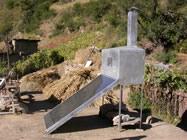|
Less than one percent of the land is arable due to steep slopes, rocks, rivers and forest cover (DPH, 2004) and snow cover for five months of the year reduces fresh food production to just 3-4 months per year. As a result, and unsurprisingly, there is chronic malnutrition among the local population. That is the reason why it is so important to save some food in Humla for later. But due to the poverty of the people and the remoteness of the area, people cannot dry and store the food properly. Even if they air dry and store it, it is done in a very unhygienic way which results in loss of quality of the products and loss of the nutritional content of the food. That is why RIDS-Nepal started to get involved in designing an appropriate Solar Drier for the people of Humla.
Currently at the RIDS-Nepal Simikot office in Humla, a solar dryer which is seen as an integral part of the running nutrition programme is under evaluation. Testing and evaluation are vital to ensure the most appropriate technologies are designed and introduced to villages.

|
The collector casing is made of galvanized iron (GI) sheet. The glazing is 3 mm thick and tempered window glass. The absorber consists of two layers. The bottom layer is a black-painted GI sheet on top of the back insulation. The top layer is a black-painted perforated plate, which rest on supports fixed to the bottom layer. Air enters the collector through an insect-proof opening on the underside of the bottom of the collector (to prevent dust stirred up by winds from entering the solar drier), which is inclined at 40° to the horizontal. A baffle at the bottom of the collector directs air in between the two absorbing layers. Some of this air passes through the perforated upper layer. The remainder stays between the two layers. Both air streams meet at the top of the collector, where the heated air enters the solar drier dryer cabinet through an opening covered with insect mesh. |
|
The cabinet contains six drying trays enough for storing a considerable amount of food. A small 12-volt, solar PV - battery powered fan system, located inside the upper chimney, can be additionally installed to vary the air flow through the collector and solar dryer.
The benefits of Solar Drier are easy to define and clear.
- Since the food is dried under defined conditions, it is easier to be able to preserve the nutritional content.
- The food is dried in a much more hygienic environment, without flies, animals or people degrading it.
- The products to be dried are protected from sudden weather changes (rain, snow, storm).
- The quality of the dried product is of higher standard and thus allows to have it be sold at the market, generating income for the family.
- The solar drier can be used for both individual family or a whole community.
|





